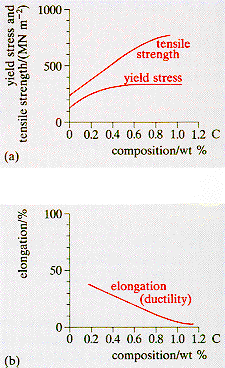| |
The diagrams
show the effect of changing the carbon content on the mechanical properties
of low carbon steels that have been annealed. It is seen (a) that the
ultimate tensile strength of these alloys increases as the carbon content is
increased and that the yield stress reaches a plateau at about 0.6 wt 5 carbon
content in the alloy. As was seen in the copper-nickel system, the ductility
of these alloys decreases as the alloy content is increased. The hypoeutectoid
steel is the most ductile and the ductility has decreased by a factor
of three for the eutectoid alloy. In hyper-eutectoid alloys the additional,
brittle cementite on the pearlite grain boundaries further decreases the ductility
of the alloy. The proeutectoid cementite restricts plastic deformation
to the ferrite lamellae in the pearlite and fracture occurs in the brittle
grain boundary zone.
In selecting such alloys for use in light-strong
structures the composition must be chosen to balance these properties to the
needs of the design. Although the demands of a front fork on a bicycle imply
the need for a high yield strength, high toughness is another requirement and
this requires tailoring the carbon content to provided the necessary ductility.
A hypoeutectoid composition might meet this need with 0.4 to 0.6 wt % C
in the alloy. Addition of other elements may also be used to further modify
properties. |
|
|
|
|
|
|
|
|
|
|
|
